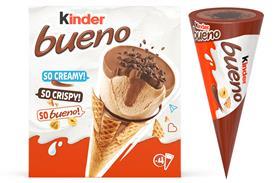Sugar and all things nice, but where’s the spice in the confectionery market’s life? Stefan Chomka reports
On the face of it, confectionery is a market in which nothing much seems to happen. A glance at the top 10 brands tells little more than what most people already know - the chocolate bars that have been around for, in some cases, 100 years or more are still there. No real surprises.
And yet, the fact that brands haven’t changed much over the past decade or two gives the unfair impression all is stable in confectionery. Companies have had to work hard over the past year in the face of pressure from the health lobby and competition from savoury snacks firms.
Take standard countlines. The largest category, according to TNS, over the past year to June 19, it dropped 1.5% in value despite a raft of new products from manufacturers. Toffees, mints and sugar fruits were also down on last year, belittling the efforts manufacturers have made to grow these categories.
A common criticism levelled at the industry is there is little innovation and too many ‘me-too’ products. Yet this is a distorted version of the truth, claims Graham Walker, Nestlé Rowntree sales communications manager.
According to Walker, 2005 has been a year in which the category has seen the most innovation in recent times. “There has been better innovation this year than over the past five or six years. It has produced a set of products that will have longevity.”
Nestlé has, so far, launched more than 30 products this year alone and is taking NPD much more seriously. “Gone are the days when companies threw a product at the wall to see if it stuck,” says Walker. “All manufacturers have been guilty of this in the past.”
Indeed, recent launches have proved very successful. Cadbury Snaps, launched in 2003, goes from strength to strength with the addition of mint, honeycomb and coconut flavours, while Nestlé claims huge growth from Aero Bubbles, launched in February.
Mike Tipping, head of customer relations at Cadbury Trebor Bassett, says NPD has had to be more closely targeted at specific eating occasions. As well as the additions to Snaps, the company has developed new variants of its block Dairy Milk and launched Share Boxes,
both aimed at the ‘big night in’ sector, in which crisp manufacturers have found a lot of joy. “Despite a very challenging year, confectionery remains a firm favourite with the nation, with penetration in excess of 93%,” says Tipping. “Understanding consumer needs and shopper behaviours is a key factor in developing an innovation strategy.”
Struggling small players in the very competitive and crowded category will no doubt be relieved to hear big companies such as Cadbury describe the year as “challenging”.
David Matthews, MD at Taste of Switzerland, says the company is moving its Swiss Delice brand out of Tesco and is instead concentrating on the independent sector. While he describes sales of the brand, launched in the UK in September 2003, as successful, he says they didn’t meet retailers’ demands. “Retailer demand for SKU performance in confectionery is high. They have space on-shelf for their core range and own label and space for alternative brands is limited.”
Organic manufacturer Green & Black’s notes retailers are cutting back to make way for more specialty listings that drive higher margins. An effective in-store display can make the difference, says Tipping. “This is the key to growing the category across the industry, irrespective of size or format.”
Bendicks, for example, is rolling out a 100g bagged version of its Mingles brand into Tesco this Christmas for better shelf stand-out, says Andy Morrison, company trade marketing manager. He adds, Masterfoods’ move of brands such as Revels, Maltesers and M&Ms into sharing pouches has proved successful. “It looks good on-shelf and has driven the brand well.”
Masterfoods supported the launch of the pouch bags with a £3m marketing campaign and says there has been massive growth in the bitesize category.
Morrison offers a word of caution on the current movement to shelf-ready packaging, however. “It is a vast and confusing category. If you’re not careful the move to retailer-ready packaging will leave shelves full of cardboard.”
Health also continues to be another potential stumbling block. Tracey Wilson, marketing manager at Fox’s Confectionery, says the company has changed its product formulation to use real fruit juice as well as fortifying them with vitamin C. “Consumers will still enjoy sweet treats, but increased nutritional awareness means demand for premium quality versions,” she says.
This year, Nestlé Rowntree also took out all artificial flavours from its fruit range. “The media and government are constantly feeding people health messages and companies are looking to damage control.”
However, while sugar may still be high on the agenda, Walker says last year’s media frenzy about trans-fats and hydrogenated vegetable oils - which many chocolate bars still contain - has dropped in consumers’ minds.
And 2006 will continue the NPD drive, says Walker. “I guarantee something from one company will be launched that you think, ‘bugger, I wish I’d thought of that’. The simplest ideas are the most effective.”
Foreign influences are also likely to creep in. “Don’t be surprised to see products from across the globe,” says Walker. “Kinder is bringing a lot of stuff from the Continent. As we do a lot more international travel it becomes easier.” With Nestlé recently launching Peanut Butter Kit Kat in Canada as well as a Café Latte variant in Japan, are these the products of tomorrow?
On the face of it, confectionery is a market in which nothing much seems to happen. A glance at the top 10 brands tells little more than what most people already know - the chocolate bars that have been around for, in some cases, 100 years or more are still there. No real surprises.
And yet, the fact that brands haven’t changed much over the past decade or two gives the unfair impression all is stable in confectionery. Companies have had to work hard over the past year in the face of pressure from the health lobby and competition from savoury snacks firms.
Take standard countlines. The largest category, according to TNS, over the past year to June 19, it dropped 1.5% in value despite a raft of new products from manufacturers. Toffees, mints and sugar fruits were also down on last year, belittling the efforts manufacturers have made to grow these categories.
A common criticism levelled at the industry is there is little innovation and too many ‘me-too’ products. Yet this is a distorted version of the truth, claims Graham Walker, Nestlé Rowntree sales communications manager.
According to Walker, 2005 has been a year in which the category has seen the most innovation in recent times. “There has been better innovation this year than over the past five or six years. It has produced a set of products that will have longevity.”
Nestlé has, so far, launched more than 30 products this year alone and is taking NPD much more seriously. “Gone are the days when companies threw a product at the wall to see if it stuck,” says Walker. “All manufacturers have been guilty of this in the past.”
Indeed, recent launches have proved very successful. Cadbury Snaps, launched in 2003, goes from strength to strength with the addition of mint, honeycomb and coconut flavours, while Nestlé claims huge growth from Aero Bubbles, launched in February.
Mike Tipping, head of customer relations at Cadbury Trebor Bassett, says NPD has had to be more closely targeted at specific eating occasions. As well as the additions to Snaps, the company has developed new variants of its block Dairy Milk and launched Share Boxes,
both aimed at the ‘big night in’ sector, in which crisp manufacturers have found a lot of joy. “Despite a very challenging year, confectionery remains a firm favourite with the nation, with penetration in excess of 93%,” says Tipping. “Understanding consumer needs and shopper behaviours is a key factor in developing an innovation strategy.”
Struggling small players in the very competitive and crowded category will no doubt be relieved to hear big companies such as Cadbury describe the year as “challenging”.
David Matthews, MD at Taste of Switzerland, says the company is moving its Swiss Delice brand out of Tesco and is instead concentrating on the independent sector. While he describes sales of the brand, launched in the UK in September 2003, as successful, he says they didn’t meet retailers’ demands. “Retailer demand for SKU performance in confectionery is high. They have space on-shelf for their core range and own label and space for alternative brands is limited.”
Organic manufacturer Green & Black’s notes retailers are cutting back to make way for more specialty listings that drive higher margins. An effective in-store display can make the difference, says Tipping. “This is the key to growing the category across the industry, irrespective of size or format.”
Bendicks, for example, is rolling out a 100g bagged version of its Mingles brand into Tesco this Christmas for better shelf stand-out, says Andy Morrison, company trade marketing manager. He adds, Masterfoods’ move of brands such as Revels, Maltesers and M&Ms into sharing pouches has proved successful. “It looks good on-shelf and has driven the brand well.”
Masterfoods supported the launch of the pouch bags with a £3m marketing campaign and says there has been massive growth in the bitesize category.
Morrison offers a word of caution on the current movement to shelf-ready packaging, however. “It is a vast and confusing category. If you’re not careful the move to retailer-ready packaging will leave shelves full of cardboard.”
Health also continues to be another potential stumbling block. Tracey Wilson, marketing manager at Fox’s Confectionery, says the company has changed its product formulation to use real fruit juice as well as fortifying them with vitamin C. “Consumers will still enjoy sweet treats, but increased nutritional awareness means demand for premium quality versions,” she says.
This year, Nestlé Rowntree also took out all artificial flavours from its fruit range. “The media and government are constantly feeding people health messages and companies are looking to damage control.”
However, while sugar may still be high on the agenda, Walker says last year’s media frenzy about trans-fats and hydrogenated vegetable oils - which many chocolate bars still contain - has dropped in consumers’ minds.
And 2006 will continue the NPD drive, says Walker. “I guarantee something from one company will be launched that you think, ‘bugger, I wish I’d thought of that’. The simplest ideas are the most effective.”
Foreign influences are also likely to creep in. “Don’t be surprised to see products from across the globe,” says Walker. “Kinder is bringing a lot of stuff from the Continent. As we do a lot more international travel it becomes easier.” With Nestlé recently launching Peanut Butter Kit Kat in Canada as well as a Café Latte variant in Japan, are these the products of tomorrow?
















No comments yet